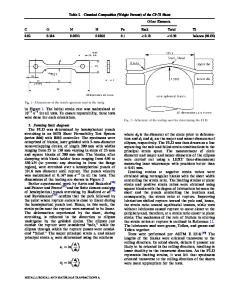Effect of Purity Levels on the High-Temperature Deformation Characteristics of Severely Deformed Titanium
- PDF / 3,705,704 Bytes
- 14 Pages / 593.972 x 792 pts Page_size
- 17 Downloads / 308 Views
TION
TITANIUM (Ti) and its alloys are appealing materials for a variety of industries. They are being typically used in biomedical, defense, aerospace, energy, and automotive applications due to their high strength to density ratio, excellent performance including fatigue, crack propagation behavior, and corrosion resistance.[1–8] The wide utilization of commercial purity (CP) titanium in the biomedical industry is due to its excellent biocompatibility.[1,2] On the other hand, the aerospace industry benefits from its remarkable specific strength.[3,4] One of the techniques available for improving strength with moderate ductility is grain refinement via severe plastic deformation (SPD).[5,6] One of the earlier works of Yapici et al.[7] investigated the flow anisotropy of ultra-fine grained (UFG) Ti with a two-step processing history. In another study, microstructural stability and mechanical properties of UFG Ti processed by equal channel angular extrusion/pressing (ECAE/P) over the range of 298 K to 673 K (25 °C to 400 °C) were investigated.[8] Meanwhile, Suwas et al.[9] studied the texture development of CP titanium during ECAE through various routes. Formation of strong textures and activation of twining due to ECAE passes were reported for commercially pure titanium.[9] Comparison of room-temperature mechanical properties of UFG grade 2 and grade 4
SEYED VAHID SAJADIFAR and GUNEY GUVEN YAPICI are with the Mechanical Engineering Department, Ozyegin University, 34794, Istanbul, Turkey. Contact email: [email protected] Manuscript submitted August 25, 2016. METALLURGICAL AND MATERIALS TRANSACTIONS A
titanium was also studied.[10] Significant enhancement in the strength levels of both grades was achieved due to grain refinement. Recently, tensile strength and microstructure evolution of grade 2 titanium processed by ECAP followed by rolling have been studied at a temperature range of 573 K to 773 K (300 °C to 500 °C).[11] Although with the rise of deformation temperature a substantial drop in flow stress levels was seen, severely deformed microstructure was found to display higher strength than the coarse-grained samples up to 773 K (500 °C). Besides, ECAE was carried out at temperatures of 323 K to 723 K (50 °C to 450 °C) to enhance the strength levels of CP titanium by the formation of nano-grains with low-angle grain boundaries (LAGBs).[12] Most of the aforementioned studies showed that ECAE is one of the most favorable SPD techniques for enhancing the mechanical properties of CP Ti in engineering applications due to its capability of maintaining dimensions after multiple processing steps.[4,6–12] On the other hand, probing the mechanical behavior along with the microstructural evolution at elevated temperatures is crucial for the adjustment of warm and hot working process parameters leading to improved workability. It is well known that dynamic recovery (DRV) and dynamic recrystallization (DRX) are influential thermal softening mechanisms for controlling the structure and properties under deformation at elevate
Data Loading...











